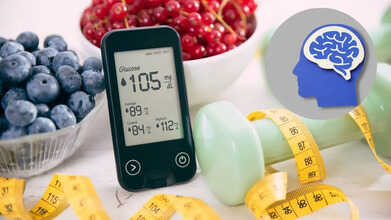- Health Conditions A-Z
- Health & Wellness
- Nutrition
- Fitness
- Health News
- Ayurveda
- Videos
- Medicine A-Z
- Parenting
Hand Conditions That May Be Symptoms Of Underlying Disease

Hands (Credit: Canva)
Your hands reflect a lot of things, including your health conditions. While things like finger trembling and swelling (in winters) are common, sometimes they can get serious. Notably, the form, function, and appearance of hands can offer important prognostic and diagnostic clues. Here are some of the diseases which can be gauged by your hands:
1. Red Hands
Redness in the hands or palms is caused by dilated capillaries and may be influenced by hormone changes in the body, which typically occur during pregnancy. Thus, red hands are common in pregnant women. Red hands, also called palmar erythema, Lane's disease, liver palms, or red palms, can also be hereditary.
2. Hand Rash
A red rash on your hand or wrist might indicate a nickel allergy, sometimes morphing into oozing blisters. Sensitivity to nickel is one of the most common causes of allergic contact dermatitis. Many everyday objects touching your skin—such as bracelets, watches, rings, and cell phones—contain nickel. You can also develop a hand rash from ingesting foods containing nickel, such as buckwheat, cashews, cocoa powder, licorice, and soy products.
Atopic dermatitis, a chronic skin condition, can also appear as a rash on the hands, causing inflammation, redness, irritation, and severe itching.
3. Finger Clubbing
Finger clubbing is a change to the nailbeds that may indicate underlying health conditions. Symptoms include large, bulging fingertips that may be red and warm to the touch, rounded nailbeds, a sharpened angle between the nailbed and cuticle, and softened nailbeds. This condition is often linked to heart and lung diseases like lung cancer, endocarditis, and congenital heart defects.
4. Hand Pain, Stiffness, and Swelling
Pain, stiffness, and swelling in your hands can occur if you have inflammatory diseases such as rheumatoid arthritis, psoriatic arthritis, or inflammatory bowel disease.
5. Hand Tremors
A little hand shakiness is common, especially if you are sleep-deprived, over-caffeinated, or experiencing alcohol withdrawal. However, persistent tremors can be a sign of neurological diseases like Parkinson's. Essential tremor, which often runs in families, causes hand and arm shakiness during tasks like eating.
6. Numb or Tingly Hands
Pins and needles in your hands could indicate carpal tunnel syndrome, especially if you experience weakness, shock-like sensations, or nighttime numbness. This condition is caused by compression of the median nerve.
7. Purple Finger Nodules
Painful red or purple bumps on your fingertips, known as Osler nodes, may signal endocarditis, a serious but rare disease causing heart inflammation.
8. Psoriasis
This chronic autoimmune condition causes thick, red patches of skin and silvery scales, often affecting the hands and nails. Palmoplantar psoriasis can lead to painful cracking, fissuring, and nail changes.
9. Trigger Finger
Trigger finger, or stenosing tenosynovitis, causes a finger to pop, catch, or get stuck when bending. This condition is often seen in people with diabetes, rheumatoid arthritis, or thyroid disease.
10. Weak Handgrip
Weak hand strength can result from aging but may also indicate poor overall health. Research links stronger handgrip strength to better heart health.
11. White, Blue, or Red Fingers
Color changes in your fingers might indicate Raynaud's phenomenon, a condition caused by reduced blood flow during cold or stress. It can cause numbness, pain, and tingling in the fingers.
Are Earphones Slowly Damaging Your Hearing? Early Signs To Watch For

Credits: Canva
Earphones have slipped into almost every part of daily life. They power music, calls, podcasts, workouts, and long online meetings. What often goes unnoticed, however, is the steady rise of a silent and irreversible condition linked to their misuse: noise-induced hearing loss.
According to the World Health Organisation, more than one billion young people worldwide are at risk of hearing damage due to unsafe listening habits involving earphones and similar devices. Health experts say this is no longer a distant concern but a growing reality, with similar listening patterns being seen across India as well.
What Is Noise-Induced Hearing Loss?
Noise-induced hearing loss, or NIHL, occurs when loud sounds damage the delicate hair cells inside the inner ear. These hair cells play a critical role in transmitting sound signals to the brain. Once damaged, they do not recover or regenerate.
Dr Vinayak Kurle, Consultant ENT at Aster RV Hospital, Bangalore, explains that prolonged exposure to loud audio is one of the most common causes. “The inner ear has a limited number of hair cells. When they are exposed to excessive noise, especially over long periods, the damage can be permanent,” he says.
The generally accepted safe listening level is 85 decibels. Exposure to sound above this level for extended durations significantly increases the risk of hearing loss. Many personal audio devices can easily cross this threshold, especially at higher volume settings.
Early Warning Signs You Should Not Ignore
Hearing damage often develops gradually, which makes it easy to overlook early symptoms. Some of the first signs include:
- Ringing or buzzing in the ears
- A blocked, muffled, or distorted sense of hearing
- Difficulty understanding speech, particularly in noisy environments
- Ear discomfort after long listening sessions
- Increased sensitivity to everyday sounds
Dr Kurle notes that many people dismiss these signs as temporary fatigue. “Ignoring early symptoms delays diagnosis and allows the damage to progress,” he says.
Why Delayed Action Can Be Harmful
Untreated hearing loss affects far more than just hearing. Over time, it can contribute to social withdrawal, low mood, reduced concentration, and a decline in work performance. Studies have also linked hearing impairment to cognitive decline when left unaddressed.
What makes NIHL especially concerning is that the damage builds slowly. By the time people realise something is wrong, hearing loss is often already permanent.
How To Protect Your Hearing?
The good news is that noise-induced hearing loss is largely preventable with simple, consistent habits. Avoiding exposure to loud noise remains the most effective step. When loud environments cannot be avoided, protective options such as earplugs, earmuffs, or noise-filtering devices can reduce risk.
Noise-cancelling earphones can also help, as they reduce the need to raise volume in noisy surroundings. Following the WHO’s 60–60 rule is another practical safeguard. This means listening at no more than 60 percent volume for no longer than 60 minutes at a time.
Experts also advise limiting total daily earphone use, keeping volume below 80 decibels, taking regular listening breaks, and scheduling periodic hearing tests. At the first sign of symptoms such as ringing or muffled hearing, consulting an ENT specialist is crucial.
“Hearing loss does not happen overnight,” Dr Kurle says. “It develops quietly over time. Healthy listening habits today are the only way to protect hearing in the long run.”
Preserving hearing requires awareness, restraint, and timely action. In a world filled with constant sound, listening safely may be one of the most important health choices we make.
Can Diabetes Increase Your Risk Of Dementia? Doctors Explain The Link

Credits: Canva
Due to rising obesity levels, sedentary lifestyles, and a rapidly aging population, type 2 diabetes has become far more common than it was a few decades ago. While high-income countries saw a decline in diabetes-related deaths between 2000 and 2010, this trend reversed from 2010 to 2016. As a result, there has been an overall 5 percent rise in premature deaths linked to diabetes since 2000.
What is especially concerning is that type 2 diabetes is now increasingly diagnosed in children, largely driven by poor diet, excess weight, and lack of physical activity. Beyond its well-known effects on the heart, kidneys, eyes, and nerves, diabetes is also associated with long-term conditions affecting the brain, including dementia.
This raises an important question: how exactly are diabetes and dementia connected? To understand this better, we spoke to Dr Prabhojit Mohanty, Psychiatrist, Sexologist, and De-addiction Specialist, who shared insights on the link.
What Is Diabetes?
Diabetes is a long-term metabolic disorder in which blood sugar levels remain consistently high. This happens either because the pancreas does not produce enough insulin or because the body is unable to use insulin properly. Insulin plays a crucial role in helping glucose enter cells to be used as energy. When this process is disrupted, sugar builds up in the bloodstream, gradually causing damage to vital organs such as the heart, eyes, kidneys, and nerves.
The two main forms are Type 1 diabetes, an autoimmune condition that requires lifelong insulin therapy, and Type 2 diabetes, which is linked to insulin resistance and influenced by lifestyle and genetic factors, according to the Cleveland Clinic.
What Is Dementia?
Dementia refers to a group of symptoms marked by a significant decline in cognitive abilities that interferes with everyday functioning. It affects memory, thinking, reasoning, and decision-making. Dementia is not a single disease but an umbrella term for conditions caused by different underlying disorders, the most common being Alzheimer’s disease.
As dementia progresses, symptoms become more severe, affecting mood, behavior, and the ability to carry out routine activities, often leading to increased dependence on others. Early diagnosis can help slow progression and improve quality of life, as noted by the Alzheimer’s Association.
Diabetes And Dementia: What Is The Link?
An expanding body of research points to a clear association between diabetes and dementia. Large-scale studies and meta-analyses indicate that individuals with diabetes face nearly a 59 percent higher risk of developing dementia compared to those without the condition. This increased risk applies to both Alzheimer’s disease and vascular dementia and tends to rise the longer a person lives with diabetes. From a clinical perspective, several mechanisms are involved. Persistently high blood sugar levels and insulin resistance cause damage to both small and large blood vessels. Over time, this harms the brain’s microvasculature, reducing blood supply and raising the likelihood of strokes and vascular dementia.
Dr Prabhojit Mohanty explained, “When diabetes occurs alongside hypertension, the danger becomes even greater. Both conditions speed up damage to blood vessels in the brain. High blood pressure weakens vessel walls and contributes to plaque formation, which further limits blood flow to the brain. From a biological standpoint, insulin has roles beyond regulating sugar. When the brain becomes resistant to insulin, it affects neuron health, communication between brain cells, and how the brain uses glucose, increasing vulnerability to neurodegenerative conditions such as Alzheimer’s disease.”
Scientists have also introduced the idea of “type 3 diabetes” to describe Alzheimer’s disease as a condition driven by insulin resistance within the brain itself. According to this theory, impaired insulin signalling in neural tissue plays a role in the buildup of amyloid plaques and tau tangles, which are defining features of Alzheimer’s disease. People with diabetes often also struggle with high blood pressure and abnormal cholesterol levels. Together, these factors further raise the risk of dementia and significantly affect the quality of life of both patients and their caregivers. Detecting diabetes early, maintaining good control of blood sugar and blood pressure, and adopting healthier lifestyle habits can go a long way in protecting cognitive function with age.
In simple terms, there is strong clinical and biological evidence showing a clear and well-established connection between diabetes and dementia.
Doctors Issue New Alert For Popular Weight-Loss Jabs Semaglutide And Tirzepatide

Credits: Canva
People using injectable weight loss drugs may need long-term medical and lifestyle support, researchers have warned, after a large study found that weight is regained far more quickly than with traditional diet and exercise plans. Scientists at the University of Oxford found that people taking medications such as semaglutide (Wegovy) and tirzepatide (Mounjaro) lose weight while on treatment, but typically regain it within around 20 months after stopping the injections.
The study also showed that improvements in blood sugar control, cholesterol levels, and blood pressure fade once the drugs are discontinued, leaving patients back at their original health markers. By comparison, people who lose weight through structured diet and exercise programmes tend to maintain the loss for longer, close to four years on average, although most eventually regain weight as well.
Health Gains Reverse After Treatment Ends
The findings come alongside separate research from University College London and the University of Cambridge, which suggests that people prescribed newer weight loss drugs could face risks such as nutrient deficiencies and loss of muscle mass. Under current NHS rules, Wegovy can only be prescribed for up to two years, while Mounjaro has no set time limit.
Most people using these medications pay for them privately, due to strict NHS eligibility criteria. Research indicates that around half stop treatment, often because of cost, side effects, or because they feel they have reached their target weight.
The Oxford analysis, published in the British Medical Journal, reviewed 37 studies involving more than 9,000 participants. On average, people stayed on medication for 10 months and were followed up for eight months after treatment ended.
Across all weight loss drugs, participants lost an average of 8.3 kg during treatment, but regained 4.8 kg within a year, returning to their starting weight within about 1.7 years. Those taking Wegovy or Mounjaro lost nearly 15 kg, but regained around 10 kg in the first year after stopping. Based on projections from one year of data, full weight regain occurred within roughly 1.5 years. Measures linked to heart and metabolic health, including blood glucose and cholesterol, also returned to baseline within about 1.4 years.
Experts Say Obesity Requires Ongoing Care
Professor Susan Jebb, professor of diet and population health at the University of Oxford and an adviser to ministers and the NHS on obesity, said the findings were clear. “What we’ve shown is that weight regain after medication is common and happens quickly. The benefits for blood sugar and cholesterol closely track weight changes, so when weight comes back, those benefits disappear too.”
She noted that weight regained after medication happens almost four times faster than after behaviour-based programmes, regardless of how much weight was initially lost. Professor Jebb said long-term solutions may be necessary, whether through ongoing medication, behavioural support, or a combination of both.
“Obesity is a chronic, relapsing condition,” she said. “It’s reasonable to expect that treatment may need to continue for life, much like medicines for high blood pressure. We should think of this as long-term treatment for a long-term condition.”
She added that combining diet and exercise programmes with drug treatment helps people lose more weight initially. However, once medication stops and appetite returns, those strategies alone often fail to prevent regain. In contrast, people in behavioural programmes without drugs may practice these habits more consistently, which could explain why weight regain is slower.
Professor Jebb said it is clear that some form of ongoing intervention is needed if the benefits of weight loss drugs are to last. Some patients try tapering doses or using medication intermittently, while others rely on lifestyle support alone, but she said evidence on what works best remains limited.
Sam West, a postdoctoral researcher at the University of Oxford and co-author of the study, said: “People on medication lose more weight than those in behavioural programmes, but they regain it about four times faster.”
The researchers also questioned whether long-term drug treatment is cost-effective for the NHS. They concluded that since obesity is a long-term, relapsing condition, extended use of weight management medications may be needed to maintain health benefits.
Concerns Over Nutrition and Muscle Loss
Separate findings published in Obesity Reviews highlighted gaps in nutritional guidance for people taking semaglutide and tirzepatide. Dr Marie Spreckley from the University of Cambridge said many patients receive little structured advice on diet quality, protein intake, or micronutrient needs, despite significant appetite suppression.
“If nutritional care isn’t built into treatment,” she said, “there’s a real risk of trading one health problem for another, through avoidable nutrient deficiencies and unnecessary muscle loss.”
An NHS spokesperson said that while these drugs are a valuable addition to weight loss treatment, they are not a quick fix. “They must be combined with lifestyle and behavioural support, including advice on healthy eating and physical activity, to help people maintain weight loss over time,” the spokesperson said.
© 2024 Bennett, Coleman & Company Limited

